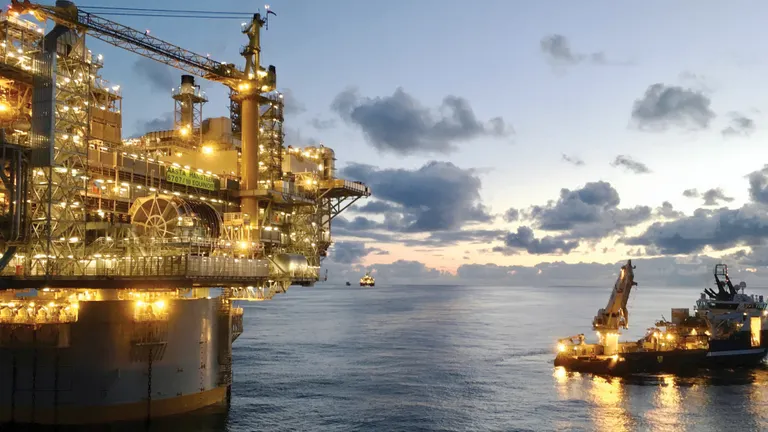Producing assets

About our non-operated fields
OMV Norge AS holds non-operated interests in four producing fields on the Norwegian Continental Shelf: Gudrun, Gullfaks, Edvard Grieg, and Aasta Hansteen. These assets are central to OMV’s production portfolio and support the Group’s strategy to strengthen energy security and increase the share of gas in its energy mix.
OMV Share: 24%
Operator: Equinor
Production Start: 7 April, 2014
Location: North Sea
Gudrun is an oil and gas field located in PL 025, about 55 km north of the Sleipner installations. It is developed with a traditional steel platform resting on the seabed, with capacity for partial treatment of hydrocarbons before transported via pipeline to Sleipner A. From there, gas is exported to European markets, and oil is routed together with Sleipner condensate to Kårstø for shipping.
The reservoir is high pressure and high temperature, requiring advanced technology, and draws on experience from Kvitebjørn and Kristin developments.
Latest update: A third infill drilling campaign was approved, with two new wells planned for 2026.
OMV Share: 19%
Operator: Equinor
Production Start: 1986
Location: North Sea (Tampen area)
Gullfaks is a mature field located in the Tampen area, developed with three integrated processing, drilling, and accommodation facilities: Gullfaks A, B, and C. These concrete-based platforms support production from several satellite fields including Tordis, Vigdis, Snorre, Visund, and Brime.
The field has undergone multiple development phases since its discovery in 1978, including enhanced recovery projects and tie-ins.
Sustainability highlight: Gullfaks is one of the first fields globally to receive power from a floating wind farm. The Hywind Tampen wind farm began supplying electricity in 2022/2023, achieving 90,000 tonnes of CO2 savings in its first year.
Latest update (2024): Nine new wells were delivered and handed over to production.
OMV Share: 20%
Operator: Aker BP
Production Start: November 2015
Location: North Sea (Block 16/1)
Edvard Grieg is a high-performing oil and gas field located approximately 180 km west of Stavanger. Developed with a bottom-fixed steel jacket and full processing facilities, the platform has consistently delivered high operational regularity and production efficiency.
The field receives oil and gas from the nearby Ivar Aasen field for final processing and export, and serves as a host platform for several tie-back developments, including Solveig Phase 1 and 2, Troldhaugen, and Symra.
Edvard Grieg operates with renewable electricity from shore via the Utsira High area solution, resulting in very low CO2 emissions.
Latest update:
- Infill drilling has extended the Edvard Grieg field life. After a production decline in 2022, a third campaign was approved in 2024 to cut unit costs and unlock reserves. Two new wells were drilled with minimal platform modifications and are now producing.
- The Solveig Phase 2 subsea tie-back is under construction, with production expected in 2026.
- Tie-ins from Troldhaugen and Symra are also progressing, further strengthening Edvard Grieg’s role as a regional hub.
OMV Share: 15%
Operator: Equinor
Production Start: 16 December, 2018
Location: Norwegian Sea (Vøring area)
Aasta Hansteen is the deepest field development on the Norwegian Continental Shelf, located at a depth of 1,300 metres and 300 km west of Sandnessjøen. It features the world’s largest spar platform – a 339-metre-tall floating structure anchored to the seabed – and is the first of its kind in Norway.
The field includes the original Luva, Haklang, and Snefrid Sør discoveries, with Snefrid Nord tied in later. Condensate is stored onboard and offloaded to shuttle tankers, while dry gas is transported via the Polarled pipeline to the Nyhamna terminal for export to the UK and Europe.
Latest update: Aasta Hansteen is currently producing at plateau. It is considered a potential host for nearby discoveries once plateau production ends. The Irpa gas discovery (formerly Asterix) will be tied back to the platform via an 80-km pipeline, with three wells planned.
Portfolio overview
In 2024, total average production from these four fields was 67 kboe/d, with approximately 59% being gas. These assets are central to OMV’s strategy to increase the share of gas in its portfolio to over 60% by 2030, supporting Europe’s energy transition.
OMV’s focus is on managing and high-grading the Norwegian Continental Shelf to mitigate decline, with gas as the priority. This also includes evaluating inorganic growth opportunities.